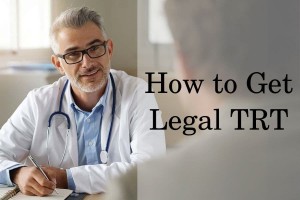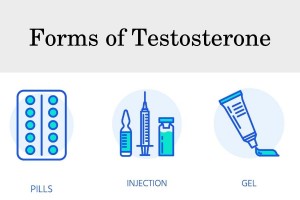In this article

If you have signs of low T, TRT can restore your hormonal levels and alleviate your symptoms.
Ask our doctors about TRT options, effects, and other unknowns related to testosterone. They will help you choose the best treatment option for you and prepare for the treatment.
How to get testosterone therapy
You can purchase legal TRT only if you have a testosterone prescription written by a medical doctor. Preferably, you should visit a specialist in endocrinology in order to receive one.

For example, you will have to undergo a blood test that will measure your testosterone. The test must be performed in the morning, around 8-10 AM when natural T should be at its peak.
According to the American Urological Association, total T results under 300 ng/dL indicate that you have hypogonadism and the test should be repeated.
If the diagnosis is confirmed, then your doctor may assign you further bloodwork in order to determine the type of hypogonadism and then offer a prescription.
You can’t purchase legal TRT without a prescription because testosterone is a medication with the potential for abuse.
It is an anabolic steroid that can be misused as a performance-enhancing drug. According to studies, anabolic steroid abuse can lead to serious health problems, psychological changes, addiction, and withdrawal.
Medical indications for the use of TRT
Male hypogonadism is the main indication for TRT. The condition leads to low levels of the male sex hormone – testosterone which regulates normal sexual function, mood, anabolic and catabolic processes in the human body.
Therefore, symptoms of low T in men can significantly impact physical and mental health and quality of life. The first symptoms usually include lack of sexual desire and depressive mood.
In the long term, the condition can lead to an increased risk of diabetes and heart disease
Low testosterone and hypogonadism can be caused by several factors which disrupt the normal function of the hypothalamic-pituitary-gonadal axis (HPG axis).
That is the part of the endocrine system which controls the production of testosterone. It involves the pituitary gland and the testicles. Depending on which gland doesn’t function properly, we have two main types of hypogonadism.
If the testicles can no longer produce T despite the stimulus of the pituitary gland, the condition is called primary hypogonadism.
On the other hand, if the pituitary gland no longer stimulates the testicles to produce hormones, the condition is called secondary hypogonadism.

In the case of secondary hypogonadism, the testicular function is preserved and TRT can be combined with medications that stimulate the natural T synthesis in the testes. These include human Chorionic Gonadotropin (hCG) and Selective Estrogen Receptor Modulators (SERMs).
People with chronic metabolic conditions such as obesity may also experience low T. However, studies report that free testosterone may remain in the normal references in such cases. Thus, free T may be a better indicator of hormonal status in patients with obesity.
Furthermore, the condition is reversible with weight loss which restores normal testosterone levels. Therefore, TRT is not necessary and the treatment is not approved for use in such patients unless there are signs of hypogonadism.
Contraindications against TRT
Certain types of cancer can be sensitive to hormones, and taking testosterone may speed up their growth. Therefore, TRT is strictly contraindicated in patients with breast and prostate cancer.
Furthermore, testosterone is not safe for patients with high blood cell count and elevated hematocrit (>54%). The hormone has an anabolic effect on blood cell production and may further worsen the condition.
Relative contraindications are:
- Hematocrit > 50%
- Future plans for fertility
- Severe prostate hypertrophy and lower urinary tract symptoms
- Heart failure or heart attack in the last 6 months
- Severe obstructive sleep apnea
What are the effects of TRT on men’s health?
Testosterone therapy can provide a wide range of benefits for men with hypogonadism:
- Higher libido
- Improved erectile function
- Muscle and strength gains
- Increased energy levels
- Fat loss
- Better mood and cognitive abilities
- Stronger bones
However, TRT may lead to side effects such as suppressing the function of the testicles, including halted spermatogenesis and infertility.
Therefore, patients with low T who are still fertile should notify their doctors if they plan to father children in the future.
Studies report that infertility caused by TRT is usually reversible, and the normal function of the testicles can be restored by stimulation with hCG and SERMs in patients with secondary hypogonadism.
Other adverse events such as acne, oily skin, prostate hypertrophy, and increased red blood cell count depend on individual sensitivity and dosage.
They can be mitigated or completely avoided by reducing the dose or changing the form of TRT.
Currently, there is not sufficient evidence linking prostate cancer and heart disease to testosterone therapy. Nevertheless, you should notify your doctor if you already have any related chronic conditions before starting the treatment.
Postmenopausal women may also experience symptoms related to low T, such as hypoactive sexual desire disorder. According to scientific evidence, testosterone therapy can improve these symptoms but the medication is yet to be approved for use in female patients.
How long to wait for changes?
The complete timeline of when all TRT benefits occur extends for up to several months after starting the therapy.
However, the first effects often take place within the first 3 weeks of therapy and include improved libido, erections, and mood. According to studies, other benefits such as increased bone strength and density may take several months to a year to occur.
The therapy also helps you lose fat while simultaneously gaining muscle. Checking your body weight and waist circumference more often can help you better notice these benefits.
Your doctor will also keep track of your T levels and monitor your therapy for adverse reactions.
Initially, you will be tested 3-6 months after starting the therapy and then once a year. The therapy aims to achieve testosterone levels in the middle of the normal reference range in healthy men.
If you had a history of osteoporosis, then your doctor may also assign you a bone density measurement 1-2 years after initiating TRT.
The tests for side effects include blood cell count, hematocrit, prostate-specific antigen (PSA), and digital rectal examination (DRE) for prostate cancer.
If there are signs of adverse reactions, you may have to discontinue the therapy.
Unfortunately, quitting TRT will likely cause your symptoms of hypogonadism to return. The treatment can’t restore the normal function of your endocrine system so the effects of the therapy last for as long as you are taking testosterone.
Furthermore, some patients may experience symptoms of withdrawal. Thus it is highly recommended to taper off the medication under medical supervision rather than quit abruptly.
Best treatment options for men
Testosterone can be administered in the body via several routes, including oral, transdermal, subcutaneous, or intramuscular. Therefore, TRT comes in different forms such as pills, gels, patches, pellets, and injections.
Testosterone pills are relatively convenient for use, as they do not require you to perform regular injections.
However, studies reveal that only 7% of the testosterone taken reaches your blood without being neutralized by the liver. Most oral formulations are also hepatotoxic, which poses health risks.
Testosterone gels or patches are another effective option and do not pose a risk for your liver health. However, the absorption and bioavailability vary a lot between individuals, which makes the method unreliable for delivering a specific dose.
Besides, using a gel hides a risk for passing the medication to another person during skin-to-skin contact. That may lead to androgenization or other health problems in the affected individual.
Testosterone pellets are implanted under the skin and release the medication continuously for 3-6 months. However, the method is not suitable for new patients since a pellet increases serum T levels very slowly.
It may take up to a month until testosterone reaches therapeutic concentration in the body. Therefore, pellets can’t provide quick relief for the symptoms of hypogonadism.
The majority of our patients prefer testosterone injections as a form of TRT. The main advantages over other forms include affordability and express results. Injections must be applied intramuscularly, every 2-12 weeks depending on the ester.
Testosterone injections are also the preferred choice by endocrinologists since they are the most reliable method in terms of dosing and achieving quick symptom management.
You can get testosterone injections online or in-person, as long as you purchase the medication from a licensed clinic that requires a medical prescription. This guarantees that you will receive safe and legal TRT.
How much does testosterone cost?
The total cost of your TRT includes the price of the medication as well as the fees for the medical exam and diagnostic tests.
TRT with injections may be fully covered by your provider
A visit to an endocrinologist usually costs $100 on average. Laboratory results may cost an additional $200 since several tests are required to confirm the diagnosis.
The cost of the medication itself depends on the form of TRT you are prescribed:
- Testosterone injections are the most affordable form of therapy, with an average monthly price of $30-$500. The exact cost will depend on brand and dosage.
- Transdermal forms of TRT cost anywhere between $650-$1300 per month.
- Oral forms of TRT have a monthly cost of $500 on average.
- Testosterone pellets cost $100-$200 per month depending on the dosage.
Legal TRT prescribed by a medical doctor is also eligible for insurance coverage. Most insurance companies will cover $30-$100 of your monthly price.

